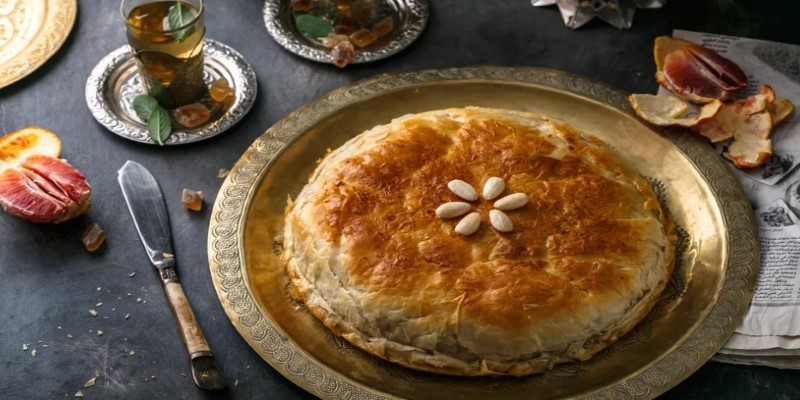If you've ever dreamt of a journey where every bite tells a story, Morocco should be at the top of your list. The magic of Moroccan cuisine is more than just its tasteit's a reflection of the country's history, culture, and vibrant spirit. Imagine sitting down to a meal thats been slow-cooked in a clay pot over smoldering coals or savoring sweet and savory pastries that blend seemingly opposing flavors in perfect harmony.
Moroccan food doesnt just feed your hunger; it feeds your curiosity, your senses, and your soul. Ready to uncover the tastes that make Morocco so unforgettable? Let's start on this flavorful adventure together.
A Culinary Journey Through Morocco: Traditional Foods You Can't-Miss
Start on a flavorful journey through Morocco's diverse cuisine, where dishes like tagine and couscous offer a taste of centuries-old traditions. From the sweet and savory mix of Bastilla to the refreshing sip of Moroccan mint tea, each bite tells a story of the country's rich cultural heritage.
Tagine
Perhaps the most iconic Moroccan dish, Tagine, is named after the conical clay pot in which it's cooked. This slow-cooked savory stew can feature lamb, chicken, or beef paired with vegetables, fruits, and nuts. The slow cooking process allows the flavors to meld beautifully, resulting in a dish that is both flavorful and aromatic. The best Tagines are served with fresh Moroccan bread, known as khobz, to scoop up every last bit of sauce. You can find tagine in almost every restaurant or street vendor in Morocco.
Couscous
Couscous is a staple of Moroccan cuisine, typically served on Fridays, the Muslim holy day. It consists of small, steamed balls of crushed durum wheat semolina and is served with a vegetable stew or meat. Traditionally, it is eaten communally from a large plate, with diners using their hands to scoop the flavorful mix. It's a beloved dish and can also be garnished with raisins, chickpeas, and a variety of vegetables.
Bastilla (Pastilla)

Bastilla is a perfect example of Moroccan cuisines love for mixing sweet and savory flavors. This pie is typically made with chicken or pigeon meat, encased in a delicate phyllo pastry, and topped with cinnamon, powdered sugar, and ground almonds. Its often served as an appetizer or at the start of special occasions. In some regions, its even prepared with fish or seafood.
Harira
Harira is a traditional Moroccan soup made from tomatoes, chickpeas, lentils, and a mix of spices like cinnamon, ginger, and coriander. This dish is especially popular during Ramadan when it's used to break the fast. It's typically served with dates and a sweet pastry called Chebakia. Rich in proteins, vitamins, and minerals, Harira can be enjoyed at any time of year and is frequently found in Moroccan restaurants.
Mint Tea (Moroccan Whiskey)
No trip to Morocco is complete without trying Moroccan mint tea, often referred to as "Moroccan whiskey." Made with gunpowder green tea, fresh mint leaves, and plenty of sugar, this drink is a cornerstone of Moroccan hospitality. It's commonly served with meals, as well as any time throughout the day. Watching a skilled tea pourer create the perfect brew is an experience in itself.
Khobz (Moroccan Bread)
Khobz is a traditional round Moroccan bread served with almost every meal. Its crusty exterior makes it perfect for scooping up dishes like tagine, Harira, and salads. Other varieties include Harcha, a buttery bread; Msemen, a flaky, layered flatbread; and Baghrir, a spongy pancake.
Brochettes
Brochettes are Moroccan meat skewers that youll often find on street corners. They are made using lamb, beef, chicken, or fish, marinated with spices, and grilled to perfection. Typically enjoyed with a sprinkle of salt and cumin, brochettes are perfect for a quick snack.
Zaalouk
Zaalouk is a cooked vegetable salad made with eggplant, tomatoes, garlic, olive oil, and spices such as cumin and paprika. This dish is often served as a side with bread and is a great example of Moroccan salads that complement the main courses.
Shebakia
Shebakia is a sweet Moroccan pastry that's especially popular during Ramadan. Made from spiced dough, the pastries are shaped into intricate flower-like forms, deep-fried until crispy, and then dipped in honey before being sprinkled with sesame seeds. Shebakia has the perfect balance of sweet and savory, making for a delightful treat.
Bisara
Bisara is a hearty soup made from dried fava beans, cooked until smooth and seasoned with olive oil, cumin, and other spices. It is often enjoyed for breakfast or lunch and is commonly served with bread.
Tanjia

Tanjia is a traditional dish from Marrakech. It is prepared using lamb or beef, slowly cooked with garlic, lemon, and a blend of spices. The dish gets its name from the urn-shaped clay pot it's cooked in. It's a favorite among locals and is often enjoyed during social gatherings.
Snail Soup
Snail soup is a local delicacy in Morocco, typically found in street food markets. The snails are simmered in a broth infused with over 15 different herbs and spices, giving it a unique flavor. The soup is served in small bowls, and the snails are pulled from their shells using a toothpick.
Moroccan Salads
Moroccan cuisine includes a wide variety of salads, both cold and hot. Popular choices include tomato jam, a sweet dip made from roasted tomatoes; Taktouka, a mix of green roasted peppers and tomatoes; and Matbukha, which features roasted bell peppers with a spicy kick.
Fried Sardines
Morocco is one of the largest exporters of sardines in the world, and this dish is a staple in coastal regions. Sardines are stuffed with a blend of herbs and spices, coated in flour, and then fried until crispy.
Conclusion
Exploring Moroccan cuisine is a sensory journey that brings together a rich mix of flavors, textures, and aromas. From the iconic tagine and couscous to the refreshing mint tea and sweet pastries, each dish tells a story of the country's diverse heritage. Trying these traditional Moroccan foods will undoubtedly make your experience in Morocco unforgettable.







